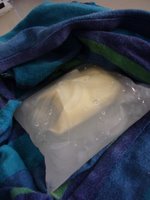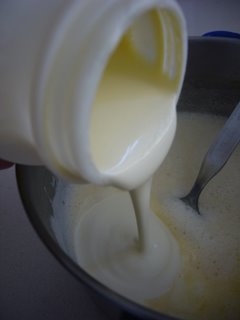

1 cup sugar
1 teaspoon salt
1 cup milk
3 beaten egg yolks
1 tablespoon vanilla extract
2 cups chilled whipping cream
Put the sugar, salt, and milk into the top pan of a double boiler. The water in the bottom part of the double boiler will boil, and the temperature will never rise above the boiling point of water. This ensures that we don't overcook the mixture. Stir the 3 beaten egg yolks into the milk and sugar. Cook the mixture over boiling water until you can see bubbles forming around the edges of the mixture. When the mixture is somewhat thick and coats the spoon, let the mixture cool to room temperature. When the custard has cooled, stir in the vanilla extract and the heavy whipping cream. 1 cup milk
3 beaten egg yolks
1 tablespoon vanilla extract
2 cups chilled whipping cream
 Pour a cup of the ice cream mixture into a plastic zip-lock sandwich bag. Zip the bag closed, and put it into another sandwich bag for safety, and zip that one closed as well. Fill a gallon size food storage zip-lock bag about one third full of ice cubes. Add a cup of salt. Zip the large bag closed, and wrap it in a towel to keep fingers from getting too cold. Now squish the little bag around in the salt and ice, making sure that the ice contacts the little bag as much as possible, and that the little bag gets lots of kneading, to keep the ice crystals tiny, so the ice cream is very smooth.
Pour a cup of the ice cream mixture into a plastic zip-lock sandwich bag. Zip the bag closed, and put it into another sandwich bag for safety, and zip that one closed as well. Fill a gallon size food storage zip-lock bag about one third full of ice cubes. Add a cup of salt. Zip the large bag closed, and wrap it in a towel to keep fingers from getting too cold. Now squish the little bag around in the salt and ice, making sure that the ice contacts the little bag as much as possible, and that the little bag gets lots of kneading, to keep the ice crystals tiny, so the ice cream is very smooth.You will know the ice cream is done by feeling the mixture become a paste instead of a liquid. When you take the little bag out of the ice, wipe off the salt water, and then remove the outer bag carefully, so you don't get salt in the ice cream. The little bag will stand up in the bowl, because it is a frozen paste.
I am hopeless at numerical logic and all things "science-y" but the girls often tell me how amazed they are when they watch me subconsciously apply complicated chemistry and physics theories into my cooking and baking. I guess working in the kitchen and chemistry could possibly be related somehow; I just could never associate my cooking with "Big-long-hard to pronounce-science-terms". I am aware of how most food and ingredients react with heat, water or each other but I've never really questioned "why" or "how"....I'm glad I found someone who has the answers. :)
How does it do that?
For ice to melt, it has to get heat from something. In our ice cream project, it gets the heat from the ice cream mixture (and from your hands, which is why they get cold while holding the bag). When the ice is melting, it is at 0 degrees Celsius (32 degrees Fahrenheit).
When ice is melting, the surface of the ice is wet. At the surface, there is solid ice on one side, and liquid water on the other. The surface is exactly at the freezing point. This means that some water molecules are leaving the ice and moving into the water, but it also means that some liquid water is refreezing onto the ice. We say that the system is in equilibrium when the rate of melting is equal to the rate of freezing, and this happens at 0 degrees Celsius.
At equilibrium, the heat lost by the water as it freezes is equal to the heat gained by the ice as it melts.
Because plain ice can only barely cool something to the freezing point of water, we will need to do something to make it much colder than that, since our ice cream mixture freezes at a lower temperature than water. The ice cream freezes because the salt and the ice mix to make a substance with a lower freezing point than ice alone. This means that the ice and salt mixture must get even more heat from somewhere in order to melt. Salty water freezes at a lower temperature than plain water. But the ice is made of plain water, so it melts at 0 degrees Celsius. Since the ice keeps melting, but the water no longer freezes (because there is only salt water, which doesn't freeze at 0 degrees), the temperature goes down.
The heat gained by the ice as it melts is no longer offset by the heat given up by freezing water (since the water is no longer freezing back onto the ice). The heat gain has to come from somewhere else. It comes from the ice cream and your hands. The sodium and chlorine in the salt split apart into charged ions, and these ions attract water molecules to form weak chemical bonds.
The resulting compound has a freezing point of -21.1 degrees Celsius (-5.98 degrees Fahrenheit). This is 21.1 degrees colder than ice (37.98 degrees Fahrenheit colder than ice). When people put salt on the ice on a sidewalk or a road, the ice mixes with the salt, and the mixture of the two solids (ice and salt) produces a liquid, but the sidewalk actually gets colder than it was before. If we add a different chemical to the ice, such as calcium chloride, we can get an even lower temperature (-29 degrees Celsius, or -20 degrees Fahrenheit).
Reference: SCI-Toys










9 comments:
nice~ i like ice cream too~ definitly get my girl friend to make this for me. Love your recipes. - j~One
hey get an ice-cream machine. My Mum used to make home-made ice-cream for my sisters and I when we were kids. You can even make delicious low fat ice-cream if you substitute the cream with milk and blended fruit.
Hey... have I told you yet?
I've started a new project called Project: Have a cookie!... and link it up ya? Thanks
www.projecthaveacookie.blogspot.com
j~one: ;)
alma: haha nah....I was just messing with a fun "experiment" not too big a fan of ice cream myself to buy an icecream maker...I have too many gadgets in my kitchen as it is *sigh* stressed up thinking of how im going to ship them home.
lex: hmm...yea ..ill check that out, sorry ive been caught up with too many things lately...
hey,u r reallly creative =) can i ask u where did u get cake box or container from?
I just hunt around for them...i never use boxes much...but I buy the cake boards from baking stores
Okie..process of making ice cream, check, easy and would try even though it sounds like a hassle, but at least will be very contented with it as it will be the fruits of my labour :P hahahaha
Scientific explanation of the making of ice cream...you lost me when I got to the sentence "In our ice cream project" hahahahahaha
Anyway, have a great weekend and wishing u all the best. Happy Mid Autumn Festival 2u
Zomg. Thermodynamics. Feels like I'm back in first year.
Ice cream making is fun, but I bet eating it is way better ;)
Mwah.
Cheer up Su! I had a long distance relationship for many years and then it's broken apart, but months later we got back together and now we're happily married, maybe yours might turn out the same. If not, as you have said it, we should move on and not live in the past...
Post a Comment